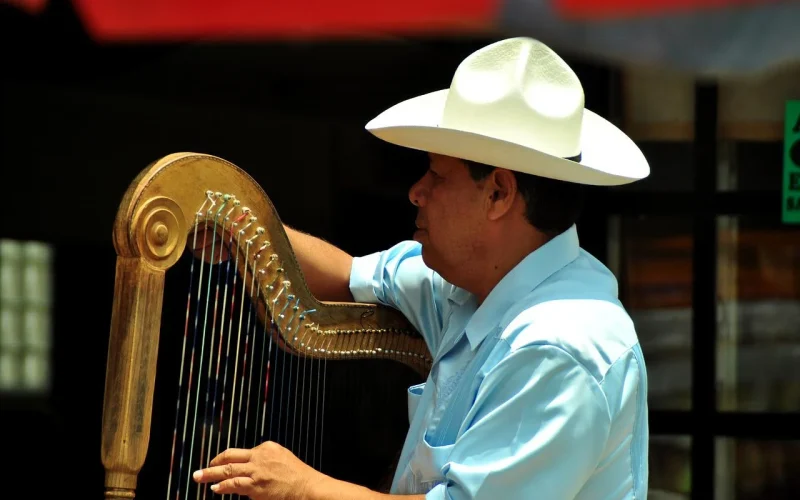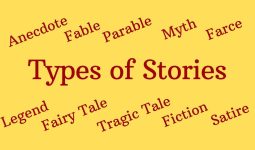There are different types of harps, varying in size and design. Harps are string musical instruments played by picking each string with both hands.
They are said to be among the earliest instruments, dating back to 15,000 BC. The instrument gained its name from the verb “to pluck” in Old German, Old Norse, and Anglo-Saxon.
Some harps are fashioned in only a single piece of wood, while others require as many as 2,000 pieces. Africa has the most diverse range of harp designs.
Below are the different types of harps.
1. Lever Harps
These are two types of harps that feature levers on the harp’s neck at the top of each string.
The levers allow the harpist to play two separate notes on each string. You may tighten or loosen each pitch to make flat, natural, or sharp notes.
However, since you’re doing this with levers that need you to use your hands, there are some limits connected with a lever harp.
This is one of the primary reasons why new harpists frequently use these harps, and in reality, singers who have completed the eighth grade typically progress to pedal harps.
2. Pedal Harps
Pedal harps are likely to be the most popular type of harp. These harps are bigger and heavier than lever harps.
It features steel strings as well as nylon strings. The number of strings can range between 40 and 47. Pedal harps, as the name implies, feature built-in pedals.
The pedals are essential for playing sharps and flats in music. A pedal harp has seven pedals.
The harpist has to use their feet to press the pedals to produce the appropriate adjustments in the tone.
Pedal harps are often more costly and difficult to master than lever harps. However, it provides the highest and most advanced music choices and quality.
That’s why many harpists start on lever harps and subsequently change to pedal harps.
3. Ancient Egyptian Harps
Many of these harps resemble modern harps because Egypt has always appreciated harps throughout its history.
Indeed, Egypt has always had a “harp culture” due to its interest in and the invention of many types of harps.
Many of the ancient harps discovered in Egypt were extremely big and lacked a pillar, implying that they lacked the support that modern instruments do.
As a result, most experts believe that the strings on these harps were likely relatively loose-fitting and possibly in the bass range.
One of these harps was known as the “benet,” and it was shaped like a spade. It was later adopted as a generic name for a harp, even after other types of harps were developed.
4. Latin-American/Paraguayan Harps
Paraguayan harps are not often used by harpists anymore. So you’ve probably never seen one in person. Latin-American/Paraguayan harps feature a straight pillar rather than the curved form of traditional harps.
It might contain between 32 and 46 strings (all even numbers). The instrument body is crafted from tropical wood, pine, and cedar.
The instrument is 4.5 to 6 feet long and weighs around 3.5 to 4.5 kilograms. It also provides a very distinctive yet lovely tone.
5. Crwth Harps
There are two types of crwth, and this type of harp is said to be connected to both the violin and the modern.
Most crwth harps are rectangular in design and contain two different portions. The back is typically flat, with an open-top side and a bottom half that resembles a soundbox.
The term “crwth” is derived from the Welsh language, and this type of harp is available in two variations.
The first is a simple rectangular form with strings in the center, while the second has a curving shape quite close to a violin. This is one of the best different types of harps.
6. Celtic/Folk Harps
The Celtic harp, often known as the Folk harp, is a traditional instrument in Ireland and Scotland. It technically has a lever harp mechanism because it lacks a pedal.
The modern Celtic harps might differ from the ancient ones. A Celtic harp comes in various sizes, with 26 to 38 strings.
Though the ancient traditional harps were quite difficult to play, the modernized versions were considerably simpler to play and maintain.
7. Harpa Doppia Harps
These harps were predominantly used in Italy and Spain, and they differed from modern harps in that they had three partial rows of strings.
The bass end had a row on the left tuned in notes ascending upward: imagine do, re, mi, and so on. The middle parallel row was tuned to sharps and began with upper bass notes.
To play these sharps, you had to either stretch between the strings on the left row or play those strings with your right hand.
The sharp row continued into the treble note range, whereas the third row, located on the far right, began on the note where the far left row stopped.
In addition, the later row covered the middle row and extended into the upper notes, indicating that you could reach the whole spectrum of musical notes with this type of harp.
8. Modern Wire Harps
While most harps have nylon strings, this type has wire strings. Its origins date back to the 14th century, and it was frequently used to support poetry and music.
Strings are often composed of brass or bronze. The size and construction of the instrument often influence the sound quality.
Its most recognized feature is the bell-like tone it generates. But the traditional wire harps can’t play flats and sharps in songs. Of course, several types provide you with extra features.
9. Lyre Harps
Most people are familiar with the lyre, a close relative of the modern harp. The lyre’s strings, which resemble those of a four-sided harp, appear open on all four.
However, many have strings that span the soundboard and even go over the bridge. Lyres from long ago differ because they have been around since 3200 BC and have been influenced by different populations.
There are even some parallels between the traditional lyre and another type of harp known as the crwth.
10. Electric Harp
Electric harps have grown in popularity among today’s artists since the late 1950s. They can be equipped with either a lever or a pedal mechanism.
It employs nearly the same playing method as acoustic harps but with the addition of a sophisticated amplification mechanism.
Electronic harps are similar to acoustic harps in that they are available in shallow and solid bodies.
It can be performed acoustically, electronically, and with or without amplification. However, the tone is never comparable to that of traditional harps.
11. Earth Harps
Most people, including artists, have never seen an earth harp. They are huge and can reach many floors in height.
Due to their size, Earth harps are played by two or more players, producing a sound that must be heard to be believed.
The earth harp has 42 strings, the longest of which is nearly 300 feet long. Its sound is distinctive, and playing it is comparable to stroking your wet finger around the rim of a glass. It is worth seeing and listening to this type of harp, which you may do online.
12. Cross-Strung Harp
A cross-strung Harp is distinct from other types of harps. It features two rows of strings that cross each other without touching.
The most intriguing feature is that it can play sharps and flats without pedals or levers. It is completely multicolored.
The X-shaped pillar will notify you that it’s a Cross-strung harp. The strings are composed of gut, nylon, or bronze.
Many find it easier to learn and play this type of Harp as it features a diatonic “home row” of strings.
13. Jaw (Jew’s Harp) or Blues Haps (Harmonicas)
The jaw and blues harps are not, in fact, harps in the proper sense, although no one knows for certain how they came to be identified as harps.
Jaw harps are typically tiny and made of steel. To play one, you hold the frame between your teeth and a single strip of steel, using your finger to play the notes.
Instead of playing different notes with your finger, the different sounds come from the contour of your mouth while the frame is in between your teeth.
If you practice long enough, you’ll be shocked at how many sounds you can make with a mouth harp.
Nobody knows why harmonicas were classified as harps, although the fact that both the harmonica and the jaw harp are played with your mouth may help explain why this happened.
14. Bell Harp
Bell harps contain at least eight strings that are tight over a soundboard and resemble dulcimers or zithers in appearance.
You pluck its wire strings with your thumbs and swing the instrument with both hands at a vertical angle.
Bell harps, also known as fairy bells or the English harp, have forms and sounds similar to bells and provide a rich, full sound that is highly pleasurable and even hypnotic.
15. Psaltery Harps
Psalteries resemble dulcimers in appearance but are played by plucking the strings with your fingers or a plectrum similar to a guitar pick.
Psaltery harps are typically triangular or square and feature soundboards and strings. Similar to dulcimers, they may be played by plucking the strings, using a bow, or hitting them with a hammer.
They can be played in various ways, but most players play them by plucking the strings.








